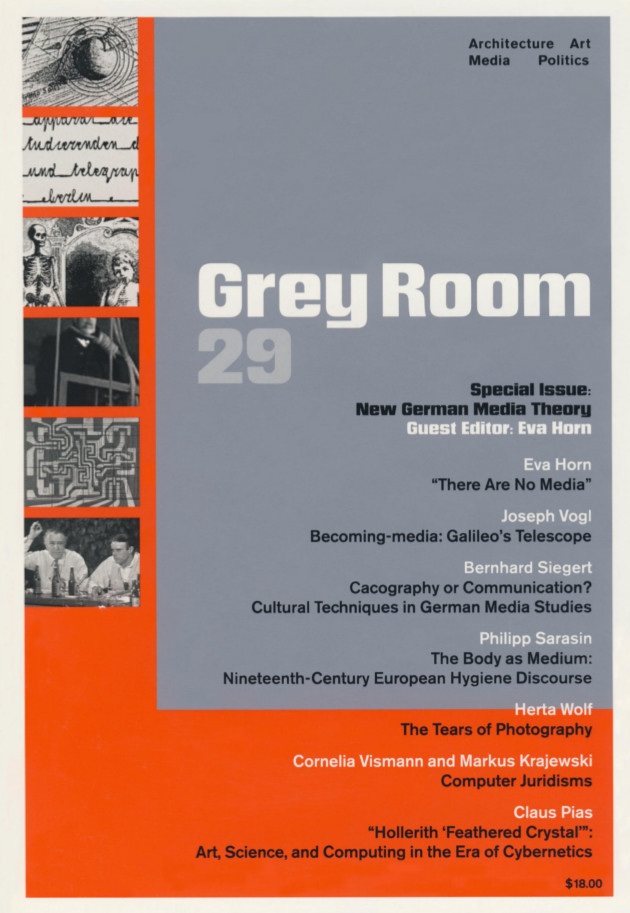Grey Room 29: New German Media Theory (2007)
Filed under journal | Tags: · aesthetics, body, code, communication, computing, cultural techniques, cybernetics, information aesthetics, law, media, media studies, media theory, mediality, technology, theory, writing

“If asked for a definition of ‘media,’ the answer given by the authors included in this volume would likely be ‘Es gibt keine Medien’–‘There are no media.’ In 1993, Friedrich Kittler published the essay ‘There Is No Software.’ Three years later, Bernhard Siegert attacked one of the fetishes of the burgeoning German media studies of the 1990s by declaring that ‘There are no mass media.’ Such a dismissal of some of the core concepts of media studies–including any fixed concept of ‘media’ itself may well be the signature of the type of ‘new media theory’ presented by the modest collection of essays in this volume.” (from the Introduction)
With contributions by Eva Horn, Joseph Vogl, Bernhard Siegert, Philipp Sarasin, Herta Wolf, Cornelia Vismann and Markus Krajewski, and Claus Pias.
Edited by Eva Horn
Publisher MIT Press, Fall 2007
ISSN 1526-3819
133 pages
Es gibt kein PDF (removed on 2014-11-15 upon request of the publisher)
Comment (0)Florian Hoenig: Computational Aesthetics and Visual Preference: An Experimental Approach (2006)
Filed under thesis | Tags: · aesthetics, complexity, computational aesthetics, computing, information aesthetics, perception, vision
Computational Aesthetics is a term which has been frequently used by scientists interested in quantitative approaches towards the concept of aesthetics during the last century. A review of both past and recent works attempting to quantify aesthetic preference of various stimuli is given, which shows that aesthetics was described as some function of complexity and order in many theories.
Since most measures were hardly relating to knowledge of human perception, complexity is reinterpreted in the context of a currently accepted model of visual perception and a hypothesis is formulated which states that human visual preference is not independent of complexity (cell excitation) at the very first stage of visual processing.
An estimate representative for cell activity in early visual processing is presented: Multivariate Gabor Filter Responses. Additionally, image properties such as aspect ratio, resolution and JPEG compressibility are used to sanity-check any correlations.
The estimate calculated, compared against human preference ratings of photographs, shows statistically significant but low correlations. However, the machine learning experiments performed, fail to predict any better than one would by taking the mean value of the data.
Even though these results only loosely relate to aesthetic perception, it’s motivating further research and closer inspection of image features and their relation to perceptual properties and visual (aesthetic) preference.
Thesis
Computer Science, JKU Linz, Austria
Supervisor Josef Scharinger
118 pages
PDF
View online (Scribd.com)
Florian Cramer: Exe.cut(up)able statements: Poetische Kalküle und Phantasmen des selbstausführenden Texts (2011) [German]
Filed under book | Tags: · aesthetics, algorithm, avant-garde, code, code poetry, experimental literature, history of literature, information aesthetics, kabbalah, literature, net art, poetry, software, text, theory

“From the antiquity to today, there has been poetry that literally performs computations, processing its own letters. Prototyped by magic and Pythagorean mathematical aesthetics, it encompasses such diverse forms as kabbalist and Lullist language combinatorics, word permutation poetry, ludistic poetry, computational text collage, aleatoric, stochastic and recursive texts, Oulipian constraints, computer-generative literature, poetry in programming languages, and codeworks. Just like visual and sound poetry poetize the graphetic and phonetic dimensions of words, these writings show that computation is a dimension of language. On top of that, their poetics is rife with speculative and contradictory programs: often one and the same text form is at once being instrumentalized for total art and anti-art, mysticism and technicism, order and chaos. This has resulted in a fantastic literature whose speculative imagination manifests itself in the arrangement of letters rather than the semantics of the text. The book includes close readings of a 17th century sonnet (Quirinus Kuhlmann’s “XLI. Libes-kuss”), a 20th century musical composition (Alvin Lucier’s “I am sitting in a room”) and a 21st century net.art codework (mez breeze’s “_Viro.Logic Condition][ing][ 1.1_”), and discusses limitations of existing literary and media theory for criticism of these works.
A shorter, less scholarly English-language mutant of this book has been electronically published in 2005 as Words Made Flesh: Code, Culture, Imagination.”
Publisher Wilhelm Fink Verlag, October 2011
343 pages
Note: the book has just become free for Open Access publishing and is offered here for download in its manuscript version, licensed under Creative Commons Attribution Unported 3.0.
Comment (0)
